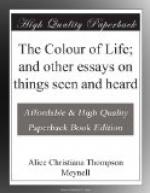Now, though the Japanese are not a destructive people, their paper does not last for ever, and that material has clearly suggested to them a different condition of ornament from that with which they adorned old lacquer, fine ivory, or other perdurable things. For the transitory material they keep the more purely pictorial art of landscape. What of Japanese landscape? Assuredly it is too far reduced to a monotonous convention to merit the serious study of races that have produced Cotman and Corot. Japanese landscape-drawing reduces things seen to such fewness as must have made the art insuperably tedious to any people less fresh-spirited and more inclined to take themselves seriously than these Orientals. A preoccupied people would never endure it. But a little closer attention from the Occidental student might find for their evasive attitude towards landscape—it is an attitude almost traitorously evasive—a more significant reason. It is that the distances, the greatness, the winds and the waves of the world, coloured plains, and the flight of a sky, are all certainly alien to the perceptions of a people intent upon little deformities. Does it seem harsh to define by that phrase the curious Japanese search for accidents? Upon such search these people are avowedly intent, even though they show themselves capable of exquisite appreciation of the form of a normal bird and of the habit of growth of a normal flower. They are not in search of the perpetual slight novelty which was Aristotle’s ideal of the language poetic ("a little wildly, or with the flower of the mind,” says Emerson of the way of a poet’s speech)—and such novelty it is, like the frequent pulse of the pinion, that keeps verse upon the wing; no, what the Japanese are intent upon is perpetual slight disorder. In Japan the man in the fields has eyes less for the sky and the crescent moon than for some stone in the path, of which the asymmetry strikes his curious sense of pleasure in fortunate accident of form. For love of a little grotesque strangeness he will load himself with the stone and carry it home to his garden. The art of such a people is not liberal art, not the art of peace, and not the art of humanity. Look at the curls and curves whereby this people conventionally signify wave or cloud. All these curls have an attitude which is like that of a figure slightly malformed, and not like that of a human body that is perfect, dominant, and if bent, bent at no lowly or niggling labour. Why these curves should be so charming it would be hard to say; they have an exquisite prankishness of variety, the place where the upward or downward scrolls curl off from the main wave is delicately unexpected every time, and—especially in gold embroideries—is sensitively fit for the material, catching and losing the light, while the lengths of waving line are such as the long gold threads take by nature.




